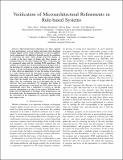| dc.contributor.author | Dave, Nirav H. | |
| dc.contributor.author | Katelman, Michael | |
| dc.contributor.author | King, Myron Decker | |
| dc.contributor.author | Mithal, Arvind | |
| dc.date.accessioned | 2012-09-28T15:08:34Z | |
| dc.date.available | 2012-09-28T15:08:34Z | |
| dc.date.issued | 2011-07 | |
| dc.identifier.isbn | 978-1-4577-0118-4 | |
| dc.identifier.isbn | 1457701189 | |
| dc.identifier.other | INSPEC Accession Number: 12145172 | |
| dc.identifier.uri | http://hdl.handle.net/1721.1/73470 | |
| dc.description | http://ieeexplore.ieee.org/xpls/abs_all.jsp?arnumber=5970511&tag=1 | en_US |
| dc.description.abstract | Microarchitectural refinements are often required to meet performance, area, or timing constraints when designing complex digital systems. While refinements are often straightforward to implement, it is difficult to formally specify the conditions of correctness for those which change cycle-level timing. As a result, in the later stages of design only those changes are considered that do not affect timing and whose verification can be automated using tools for checking FSM equivalence. This excludes an essential class of microarchitectural changes, such as the insertion of a register in a long combinational path to meet timing. A design methodology based on guarded atomic actions, or rules, offers an opportunity to raise the notion of correctness to a more abstract level. In rule-based systems, many useful refinements can be expressed simply by breaking a single rule into smaller rules which execute the original operation in multiple steps. Since the smaller rule executions can be interleaved with other rules, the verification task is to determine that no new behaviors have been introduced. We formalize this notion of correctness and present a tool based on SMT solvers that can automatically prove that a refinement is correct, or provide concrete information as to why it is not correct. With this tool, a larger class of refinements at all stages of the design process can be verified easily. We demonstrate the use of our tool in proving the correctness of the refinement of a processor pipeline from four stages to five. | en_US |
| dc.description.sponsorship | National Science Foundation (U.S.) (NSF (#CCF-0541164)) | en_US |
| dc.language.iso | en_US | |
| dc.publisher | Institute of Electrical and Electronics Engineers | en_US |
| dc.relation.isversionof | http://dx.doi.org/10.1109/MEMCOD.2011.5970511 | en_US |
| dc.rights | Creative Commons Attribution-Noncommercial-Share Alike 3.0 | en_US |
| dc.rights.uri | http://creativecommons.org/licenses/by-nc-sa/3.0/ | en_US |
| dc.source | MIT web domain | en_US |
| dc.title | Verification of microarchitectural refinements in rule-based systems | en_US |
| dc.type | Article | en_US |
| dc.identifier.citation | Dave, Nirav et al. “Verification of Microarchitectural Refinements in Rule-based Systems.” 2011 9th IEEE/ACM International Conference on Formal Methods and Models for Codesign (MEMOCODE) IEEE, 11-13 July 2011. 61–71. Web. | en_US |
| dc.contributor.department | Massachusetts Institute of Technology. Computer Science and Artificial Intelligence Laboratory | en_US |
| dc.contributor.approver | Mithal, Arvind | |
| dc.contributor.mitauthor | Dave, Nirav H. | |
| dc.contributor.mitauthor | Mithal, Arvind | |
| dc.contributor.mitauthor | King, Myron Decker | |
| dc.relation.journal | 2011 9th IEEE/ACM International Conference on Formal Methods and Models for Codesign (MEMOCODE) | en_US |
| dc.eprint.version | Author's final manuscript | en_US |
| dc.type.uri | http://purl.org/eprint/type/ConferencePaper | en_US |
| dspace.orderedauthors | Dave, Nirav; Katelman, Michael; King, Myron; Arvind, Myron; Meseguer, Jose | en |
| dc.identifier.orcid | https://orcid.org/0000-0002-9737-2366 | |
| dc.identifier.orcid | https://orcid.org/0000-0003-2075-4654 | |
| dspace.mitauthor.error | true | |
| mit.license | OPEN_ACCESS_POLICY | en_US |
| mit.metadata.status | Complete | |
